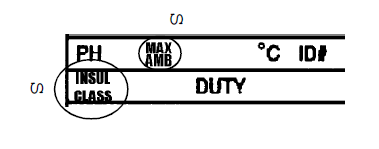Rated Full Load Speed
The rated full load speed, or rpm (revolutions per minute) of a motor is the speed at which the motor will operate under full torque conditions when applied voltage and frequency are held constant at the rated values. On standard induction motors, the full load speed, or actual speed, will normally be between 95 and 99% of synchronous speed. This is also known as slip.

Synchronous speed is the theoretical speed of a motor based on the rotating magnetic field. The formula for obtaining synchronous speed is

The number of poles and the speed of an induction motor are used interchangeably. If you know one, you can determine the other with the formula shown above. Standard rpms are as follows:
| TYPICAL ACTUAL SPEED | SYNCHRONOUS SPEED | NUMBER OF POLES |
|---|---|---|
| 3530 | 3600 | 2 |
| 1750 | 1800 | 4 |
| 1175 | 1200 | 6 |
| 880 | 900 | 8 |
**Rated Temperature Rise Or The Insulation
System Class and Rated Ambient Temperature**

One of the most critical items relating to the life of any type of electrical equipment (ranging from televisions to giant power generators) is the maximum temperature that occurs at the hottest point within the unit and the length of time that the high temperature is allowed to exist. The maximum allowable safe operating temperature occurring at the hottest spot within a motor is determined by:
- The temperature of the air surrounding the motor. This is the ambient temperature. Motors are rated using a 40°C ambient (104°F).
- The heat created within the motor due to its operation at a fully loaded condition. This is the temperature rise.
- The thermal capability of all the insulating materials used within the motor. For simplicity, these materials have been broken into classes A, B, F and H.
This standard 20,000 hour life temperature class is based on ambient plus the heat created within the motor during operation. Please keep in mind that motors are designed to withstand some very high temperatures. As an example, Class B is rated at 130°C, which is 266°F, or 54 degrees above the boiling point of water. Motors have been designed to withstand this type of heat.
Insulating materials prevent metal to metal contact or interaction of phase to phase shorts. This is also known as dielectric strength - it limits the effects of voltage variations. Insulation System Classes are as follows:
| CLASS | 20,000 HOUR LIFE TEMPERATURE |
|---|---|
| A | 105 °C |
| B | 130 °C |
| F | 155 °C |
| H | 180 °C |
